Study on the Quantitative Precipitation Estimation of X-Band Dual-Polarization Phased Array Radar from Specific Differential Phase
Abstract
1. Introduction
2. Data and Methods
2.1. PARs and DSD Measurement
2.2. Parameterization of Radar
2.3. QPE Algorithm and Quantification
2.4. Attenuation Correction
3. Quantitative Precipitation Estimation
4. Relation to Microphysical Characteristics
5. Conclusions
- (1)
- First, the two-year summer DSD observations by a 2DVD in South China and the T-matrix simulation algorithm were used to calculate the corresponding dual-polarization radar variables. The attenuation correction relationships for X-band dual-polarization radars were established. Through an example, it was found that the KDP-AH relationship can correct the X-band attenuation to a certain extent. However, in heavy rainfall, the far-end correction performance was not good (Figure 5 and Figure 6). The disagreement between the attenuation-corrected measurement of the X-band PARs and the S-band measurement was mainly due to DSD uncertainty in attenuation correction, measurement errors, the lack of co-location of the radars, and the wavelength difference. Compared to S-band observations, the X-band echoes can disappear when the signal-to-noise ratio drops to a certain level due to severe attenuation, resulting in different estimated rainfall areas for X- and S-band radars. This could be partially compensated by the cooperative observation of radar networks in the future.
- (2)
- The precipitation relations R(Zh) and R(KDP) for X-band and S-band dual-polarization radars were established. The results showed that there were some differences between the corresponding coefficients of each relationship. For the same rainfall rate, the KDP value of the X-band polarization radar was approximately 2–4 times that of the S-band, which shows that KDP observed by short-wavelength radars has a higher sensitivity for QPE than that of S-band radars. The estimated R(KDP) of the fitted relationship was compared with the rainfall rate R directly calculated from DSD data, and it was found that the X-band estimator was better than that of the S-band radar.
- (3)
- The radar QPE results of the three precipitation processes (the pre-summer rainband, typhoon precipitation rainband, and local severe convective precipitation rainband) in 2020 were evaluated. When the rain rate was low (e.g., <10 mm/h), the X-band and S-band radars had great uncertainty for rainfall estimation. As the rainfall got more intense, the KDP was less affected by the DSD uncertainty and measurement errors, and the accuracy of the X-band and S-band radar to estimate the rain rate improved. It is also noted that there was an overestimation for the heaviest rainfall, while the estimates from the X-band PAR radar were more accurate than those from the S-band radar. For fast-moving weather systems, the X-band PARs demonstrated the advantages of temporal resolution. However, the X-band’s attenuation impact in the strong echo area cannot be disregarded and can be supplemented by observations of the X-band radars in other directions, which is why more and more X-band PAR radar networks are being constructed.
- (4)
- The ZH-ZDR distributions were useful for determining the variety of DSDs in various precipitation systems. It was found that the mean size of raindrops in the typhoon precipitation rainband was smaller than the other two events, and the X-band PARs with high spatiotemporal resolution observation ability can capture minute-level microphysical process changes and improve the estimation accuracy of the ground rainfall rate through accumulation and networking observation.
Author Contributions
Funding
Institutional Review Board Statement
Informed Consent Statement
Data Availability Statement
Acknowledgments
Conflicts of Interest
References
- Seliga, T.A.; Bringi, V.N. Potential Use of Radar Differential Reflectivity Measurements at Orthogonal Polarizations for Measuring Precipitation. J. Appl. Meteorol. 1976, 15, 69–76. [Google Scholar] [CrossRef]
- Brunkow, D.; Bringi, V.N.; Kennedy, P.C.; Rutledge, S.A.; Chandrasekar, V.; Mueller, E.A.; Bowie, R.K. A Description of the CSU-CHILL National Radar Facility. Am. Meteorol. Soc. 2000, 17, 1596–1608. [Google Scholar] [CrossRef]
- Anagnostou, M.N.; Kalogiros, J.; Anagnostou, E.N.; Papadopoulos, A. Experimental results on rainfall estimation in complex terrain with a mobile X-band polarimetric weather radar. Atmos. Res. 2009, 94, 579–595. [Google Scholar] [CrossRef]
- Anagnostou, M.N.; Kalogiros, J.; Anagnostou, E.N.; Tarolli, M.; Papadopoulos, A.; Borga, M. Performance evaluation of high-resolution rainfall estimation by X-band dual-polarization radar for flash flood applications in mountainous basins. J. Hydrol. 2010, 394, 4–16. [Google Scholar] [CrossRef]
- Zhao, G.; Chu, R.; Zhang, T.; Li, J.; Shen, J.; Wu, Z. Improving the rainfall rate estimation in the midstream of the Heihe River Basin using raindrop size distribution. Hydrol. Earth Syst. Sci. 2011, 15, 943–951. [Google Scholar] [CrossRef]
- Wang, Y.; Chandrasekar, V. Quantitative Precipitation Estimation in the CASA X-band Dual-Polarization Radar Network. J. Atmos. Ocean. Technol. 2010, 27, 1665–1676. [Google Scholar] [CrossRef]
- Shakti, P.C.; Maki, M.; Shimizu, S.; Maesaka, T.; Kim, D.S.; Lee, D.I.; Iida, H. Correction of Reflectivity in the Presence of Partial Beam Blockage over a Mountainous Region Using X-Band Dual Polarization Radar. J. Hydrometeorol. 2013, 14, 744–764. [Google Scholar] [CrossRef]
- Matrosov, S.Y.; Cifelli, R.; Gochis, D. Measurements of Heavy Convective Rainfall in the Presence of Hail in Flood-Prone Areas Using an X-Band Polarimetric Radar. J. Appl. Meteorol. Climatol. 2013, 52, 395–407. [Google Scholar] [CrossRef]
- Koffi, A.K.; Gosset, M.; Zahiri, E.P.; Ochou, A.D.; Kacou, M.; Cazenave, F.; Assamoi, P. Evaluation of X-band polarimetric radar estimation of rainfall and rain drop size distribution parameters in West Africa. Atmos. Res. 2014, 143, 438–461. [Google Scholar] [CrossRef]
- Vulpiani, G.; Baldini, L.; Roberto, N. Characterization of Mediterranean hail-bearing storms using an operational polarimetric X-band radar. Atmos. Meas. Tech. 2015, 8, 4681–4698. [Google Scholar] [CrossRef]
- Anagnostou, M.; Nikolopoulos, E.; Kalogiros, J.; Anagnostou, E.; Marra, F.; Mair, E.; Bertoldi, G.; Tappeiner, U.; Borga, M. Advancing Precipitation Estimation and Streamflow Simulations in Complex Terrain with X-Band Dual-Polarization Radar Observations. Remote Sens. 2018, 10, 1258. [Google Scholar] [CrossRef]
- Rinehart, R.E.; Garvey, E.T. Three-dimensional storm motion detection by conventional weather radar. Nature 1978, 273, 287–289. [Google Scholar] [CrossRef]
- Shapiro, A.; Robinson, P.; Wurman, J.; Gao, J. Single-Doppler Velocity Retrieval with Rapid-Scan Radar Data. J. Atmos. Ocean. Technol. 2003, 20, 1758–1775. [Google Scholar] [CrossRef]
- Pazmany, A.L.; Mead, J.B.; Bluestein, H.B.; Snyder, J.C.; Houser, J.B. A Mobile Rapid-Scanning X-band Polarimetric (RaXPol) Doppler Radar System. J. Atmos. Ocean. Technol. 2013, 30, 1398–1413. [Google Scholar] [CrossRef]
- Palmer, R.; Bodine, D.; Kollias, P.; Schvartzman, D.; Zrnić, D.; Kirstetter, P.; Zhang, G.; Yu, T.Y.; Kumjian, M.; Cheong, B.; et al. A Primer on Phased Array Radar Technology for the Atmospheric Sciences. Bull. Am. Meteorol. Soc. 2022, 103, E2391–E2416. [Google Scholar] [CrossRef]
- Zrnic, D.S.; Kimpel, J.F.; Forsyth, D.E.; Shapiro, A.; Crain, G.; Ferek, R.; Heimmer, J.; Benner, W.; McNellis, F.T.J.; Vogt, R.J. Agile-Beam Phased Array Radar for Weather Observations. Bull. Am. Meteorol. Soc. 2007, 88, 1753–1766. [Google Scholar] [CrossRef]
- Guifu, Z.; Doviak, R.J.; Zrnic, D.S.; Crain, J.; Staiman, D.; Al-Rashid, Y. Phased Array Radar Polarimetry for Weather Sensing: A Theoretical Formulation for Bias Corrections. IEEE Trans. Geosci. Remote Sens. 2009, 47, 3679–3689. [Google Scholar] [CrossRef]
- Doviak, R.J.; Lei, L.; Zhang, G.; Meier, J.; Curtis, C. Comparing Theory and Measurements of Cross-Polar Fields of a Phased Array Weather Radar. IEEE Geosci. Remote Sens. Lett. 2011, 8, 1002–1006. [Google Scholar] [CrossRef]
- Zrnic, D.S.; Zhang, G.; Doviak, R.J. Bias Correction and Doppler Measurement for Polarimetric Phased Array Radar. IEEE Trans. Geosci. Remote Sens. 2011, 49, 843–853. [Google Scholar] [CrossRef]
- Wu, C.; Liu, L.; Liu, X.; Li, G.; Chen, C. Advances in Chinese Dual-Polarization and Phased Array Weather Radars: Observational Analysis of a Supercell in Southern China. J. Atmos. Ocean. Technol. 2018, 35, 1785–1806. [Google Scholar] [CrossRef]
- Adachi, T.; Mashiko, W. High Temporal-Spatial Resolution Observation of Tornadogenesis in a Shallow Supercell Associated With Typhoon Hagibis (2019) Using Phased Array Weather Radar. Geophys. Res. Lett. 2020, 47, e2020GL089635. [Google Scholar] [CrossRef]
- Otsuka, S.; Tuerhong, G.; Kikuchi, R.; Kitano, Y.; Taniguchi, Y.; Ruiz, J.J.; Satoh, S.; Ushio, T.; Miyoshi, T. Precipitation Nowcasting with Three-Dimensional Space–Time Extrapolation of Dense and Frequent Phased Array Weather Radar Observations. Weather. Forecast. 2015, 31, 329–340. [Google Scholar] [CrossRef]
- Adachi, T.; Kusunoki, K.; Yoshida, S.; Arai, K.I.; Ushio, T. High-Speed Volumetric Observation of a Wet Microburst Using X-Band Phased Array Weather Radar in Japan. Mon. Weather. Rev. 2016, 144, 3749–3765. [Google Scholar] [CrossRef]
- Kikuchi, H.; Ushio, T.; Mizutani, F.; Wada, M. Improving the Accuracy of Rain Rate Estimates Using X-Band Phased Array Weather Radar Network. IEEE Trans. Geosci. Remote Sens. 2018, 56, 6986–6994. [Google Scholar] [CrossRef]
- Kikuchi, H.; Suezawa, T.; Ushio, T.; Takahashi, N.; Hanado, H.; Nakagawa, K.; Osada, M.; Maesaka, T.; Iwanami, K.; Yoshimi, K.; et al. Initial Observations for Precipitation Cores With X-Band Dual Polarized Phased Array Weather Radar. IEEE Trans. Geosci. Remote Sens. 2020, 58, 3657–3666. [Google Scholar] [CrossRef]
- Islam, T. The scattering simulation of DSDs and the polarimetric radar rainfall algorithms at C-band frequency. J. Atmos. Sol. -Terr. Phys. 2014, 119, 42–52. [Google Scholar] [CrossRef]
- You, C.H.; Lee, D.I.; Kang, M.Y. Rainfall Estimation Using Specific Differential Phase for the First Operational Polarimetric Radar in Korea. Adv. Meteorol. 2014, 2014, 413717. [Google Scholar] [CrossRef]
- Zhang, G.; Vivekanandau, J.; Brandes, E. A method for estimating rain rate and drop size distribution from polarimetric radar measurements. IEEE Trans. Geosci. Remote Sens. 2001, 39, 830–841. [Google Scholar] [CrossRef]
- Brandes, E.A.; Zhang, G.; Vivekanandan, J. Experiments in Rainfall Estimation with a Polarimetric Radar in a Subtropical Environment. J. Appl. Meteorol. 2002, 41, 674–685. [Google Scholar] [CrossRef]
- Wang, M.; Zhao, K.; Xue, M.; Zhang, G.; Liu, S.; Wen, L.; Chen, G. Precipitation microphysics characteristics of a Typhoon Matmo (2014) rainband after landfall over eastern China based on polarimetric radar observations. J. Geophys. Res. Atmos. 2016, 121, 12–415. [Google Scholar] [CrossRef]
- Wen, L.; Zhao, K.; Zhang, G.; Xue, M.; Zhou, B.; Liu, S.; Chen, X. Statistical characteristics of raindrop size distributions observed in East China during the Asian summer monsoon season using 2-D video disdrometer and Micro Rain Radar data. J. Geophys. Res. Atmos. 2016, 121, 2265–2282. [Google Scholar] [CrossRef]
- Ryzhkov, A.V.; Giangrande, S.E.; Schuur, T.J. Rainfall estimation with a polarimetric prototype of the operational WSR-88D radar. J. Appl. Meteorol. 2003, 44, 502–515. [Google Scholar] [CrossRef]
- Liu, C.; Zipser, E.J. Global distribution of convection penetrating the tropical tropopause. J. Geophys. Res. 2005, 110. [Google Scholar] [CrossRef]
- Huang, G.J.; Bringi, V.N.; Munchak, S.J.; Kummerow, C.D.; Marks, D.A.; Wolff, D.B. Comparison of Drop Size Distribution Parameter (D0) and Rain Rate from S-Band Dual-Polarized Ground Radar, TRMM Precipitation Radar (PR), and Combined PR–TMI: Two Events from Kwajalein Atoll. J. Atmos. Ocean. Technol. 2012, 29, 1603–1616. [Google Scholar] [CrossRef]
- Matrosov, S.Y.; Cifelli, R.; Neiman, P.J.; White, A.B. Radar Rain-Rate Estimators and Their Variability due to Rainfall Type: An Assessment Based on Hydrometeorology Testbed Data from the Southeastern United States. J. Appl. Meteorol. Climatol. 2016, 55, 1345–1358. [Google Scholar] [CrossRef]
- Kumjian, M.R.; Prat, O.P.; Reimel, K.J.; van Lier-Walqui, M.; Morrison, H.C. Dual-Polarization Radar Fingerprints of Precipitation Physics: A Review. Remote Sens. 2022, 14, 3706. [Google Scholar] [CrossRef]
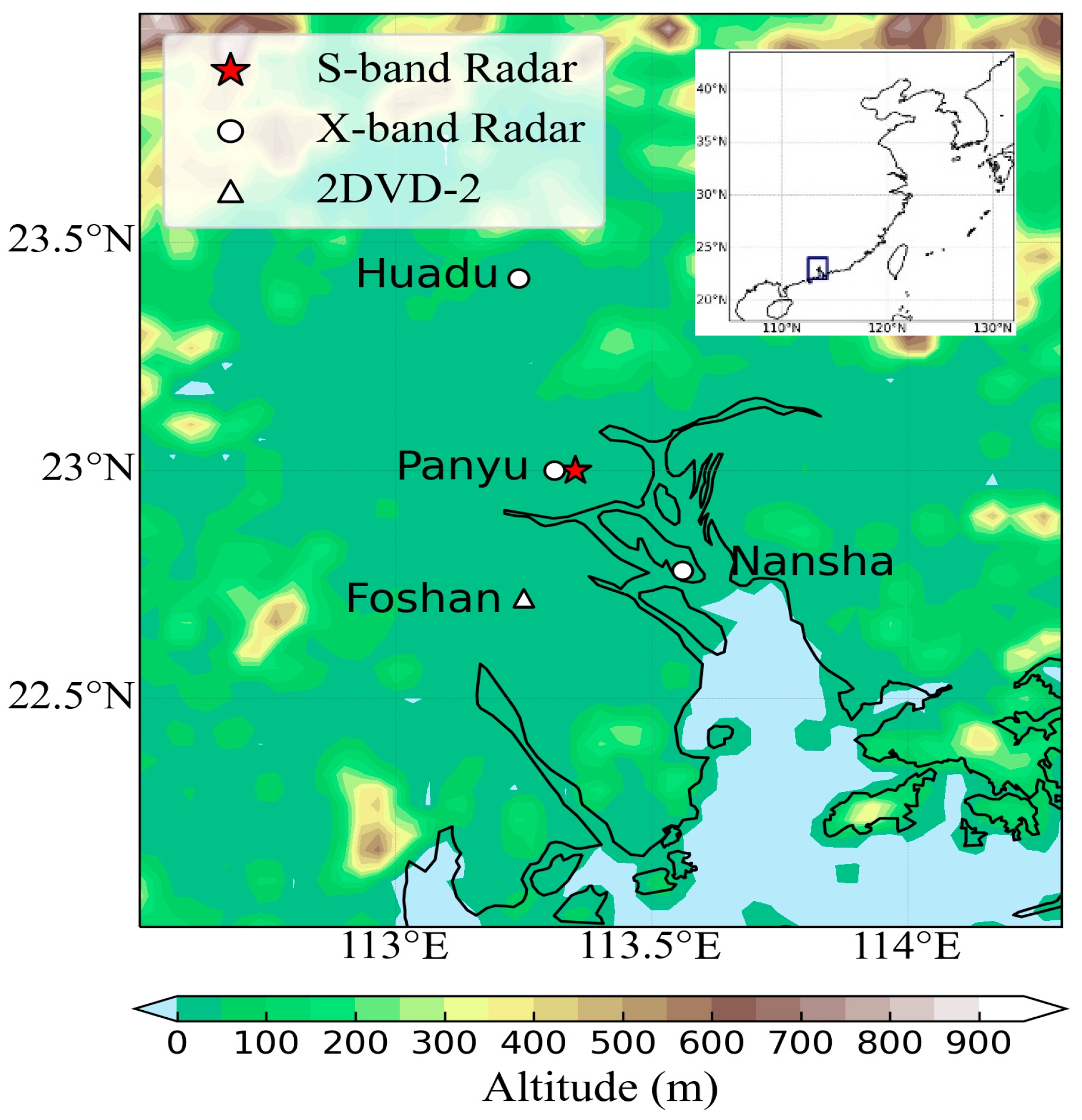
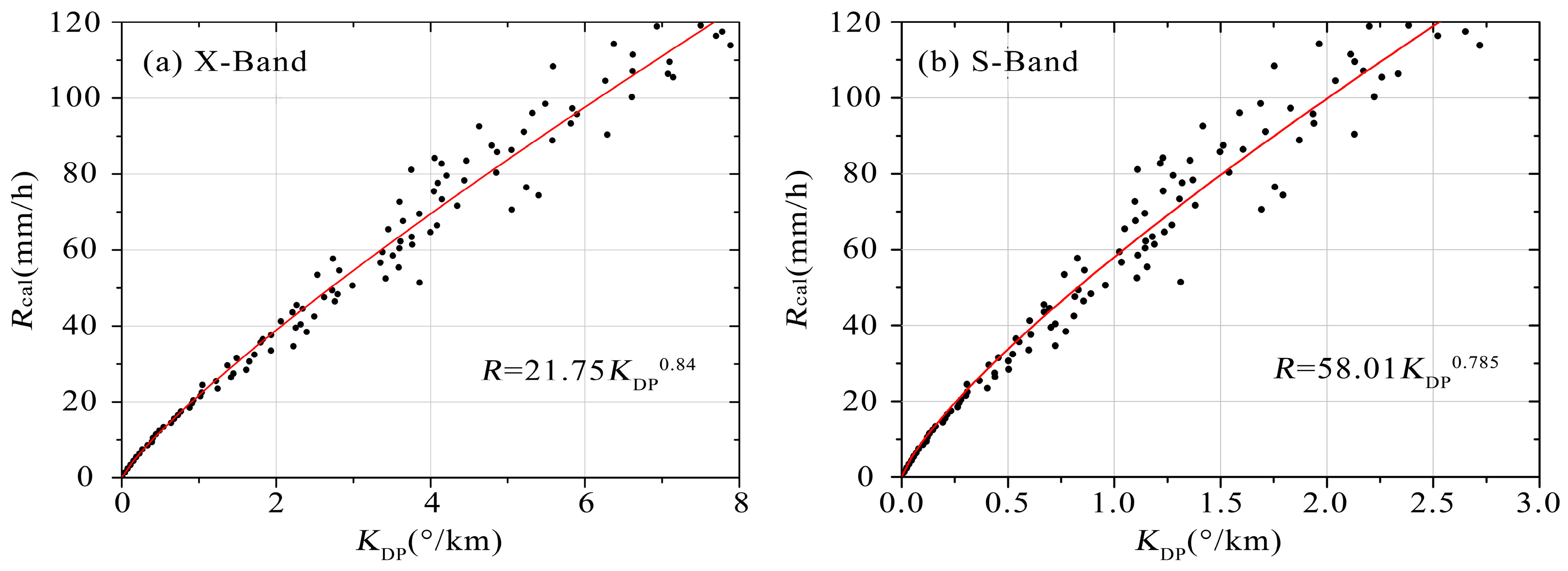
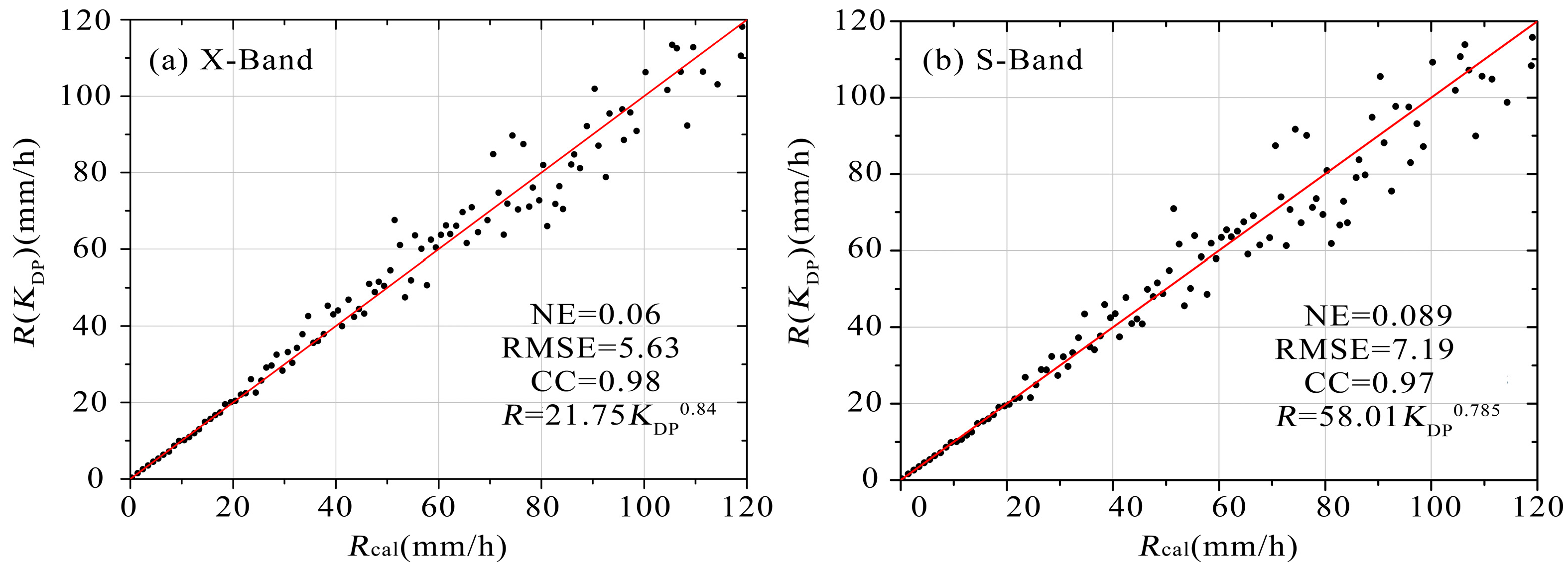
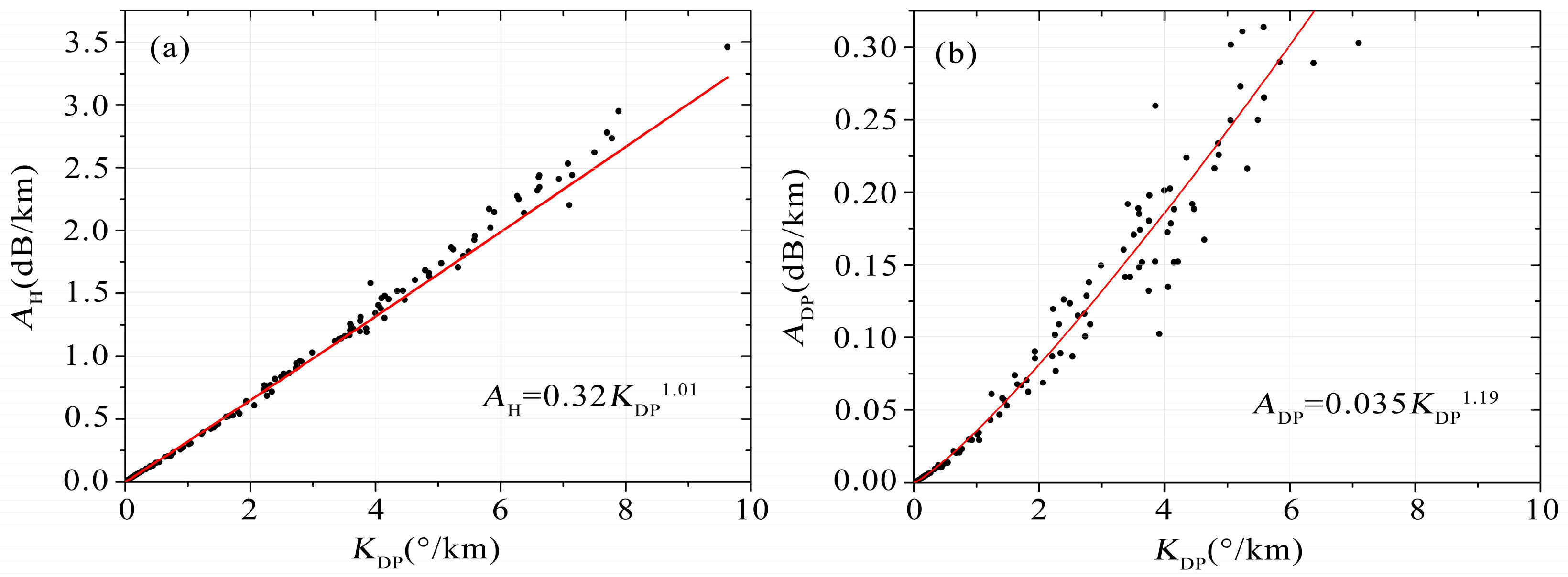

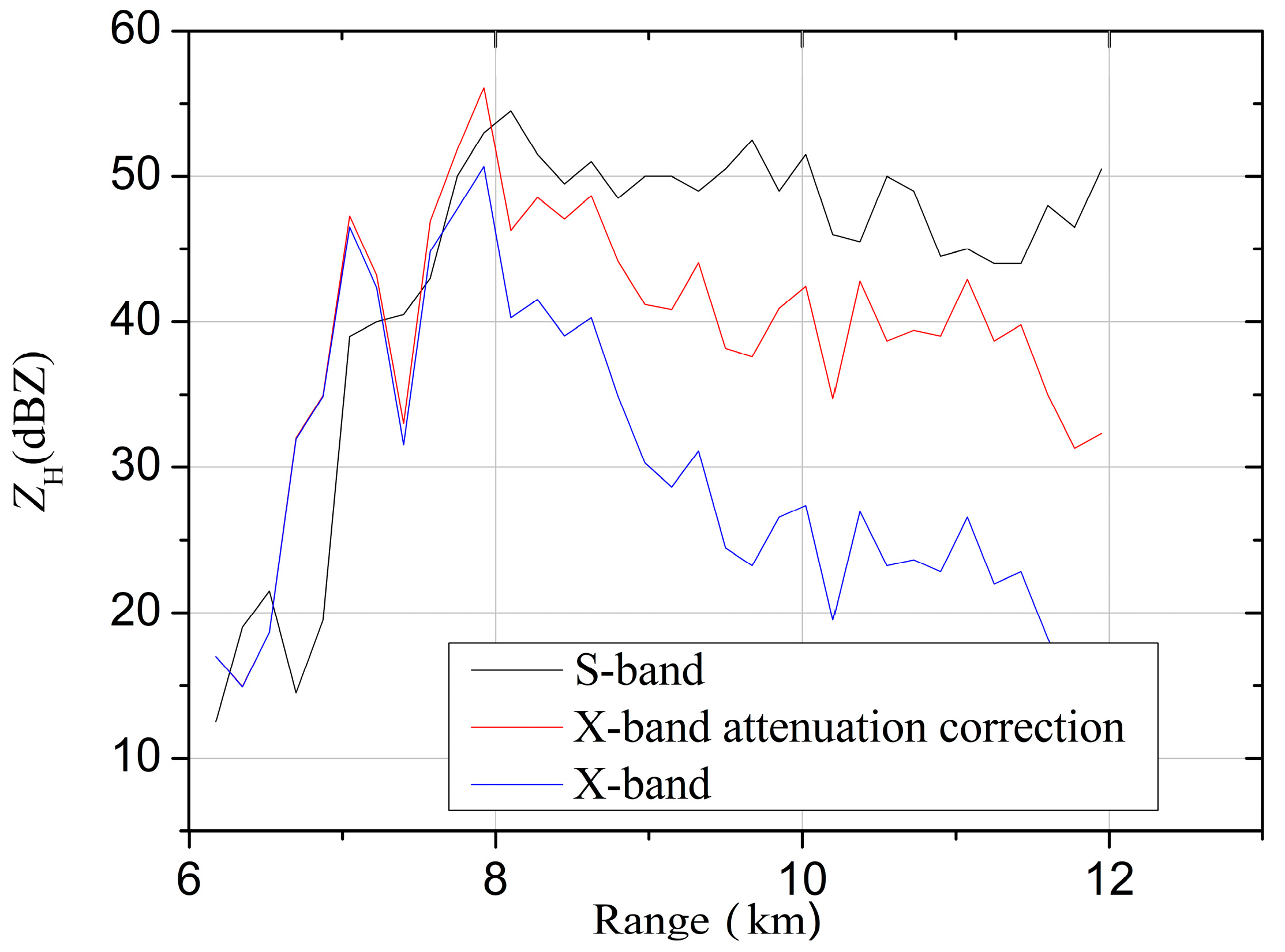
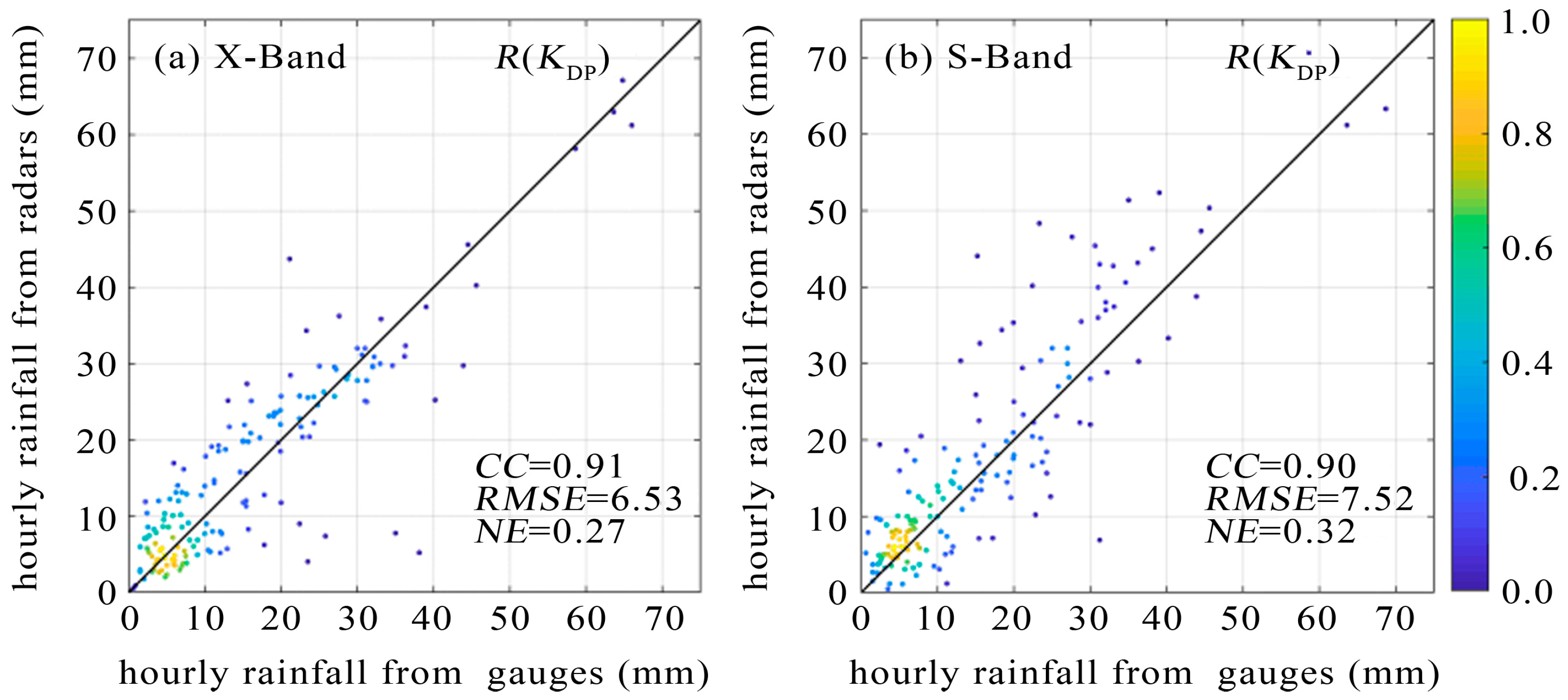
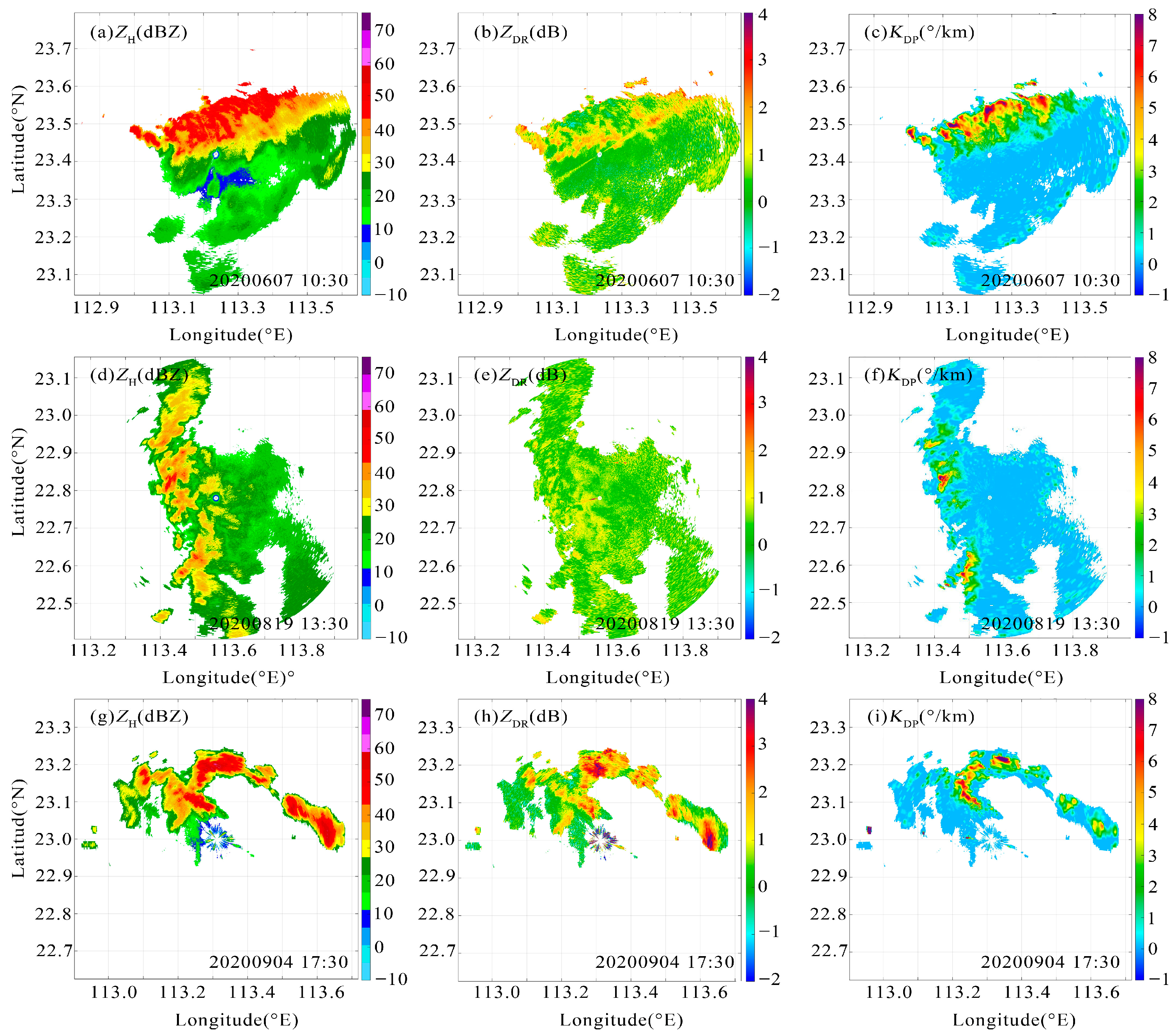
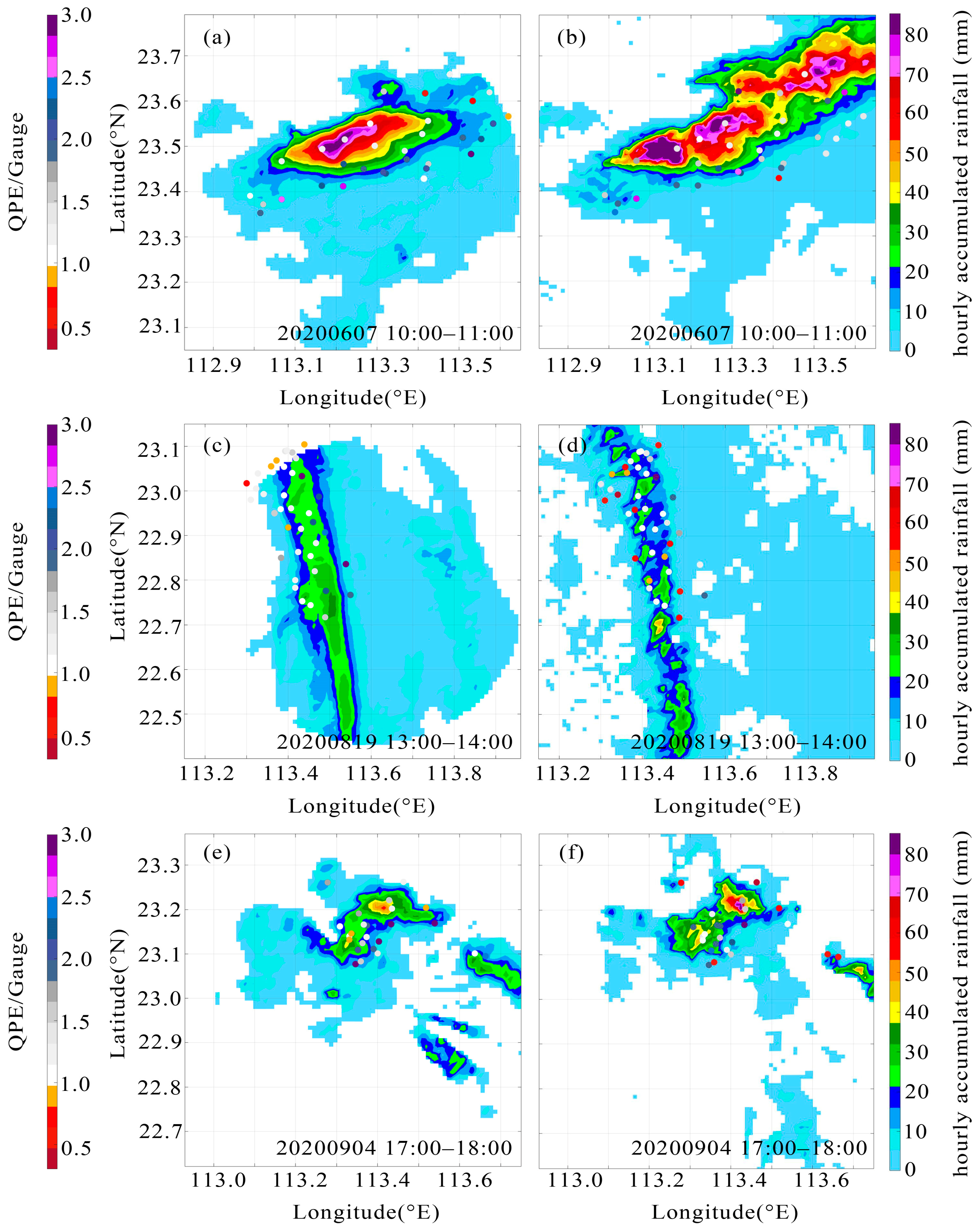
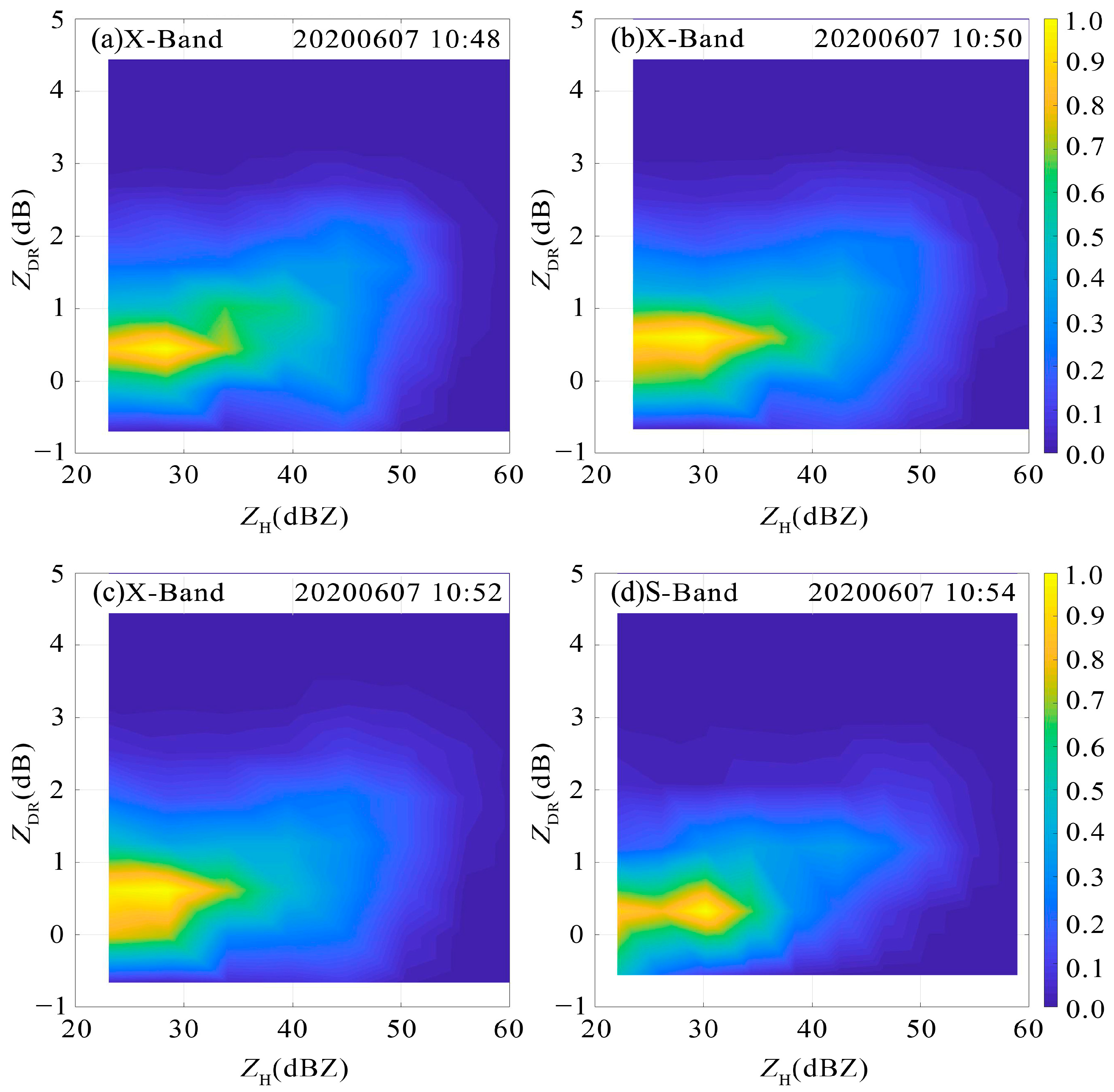
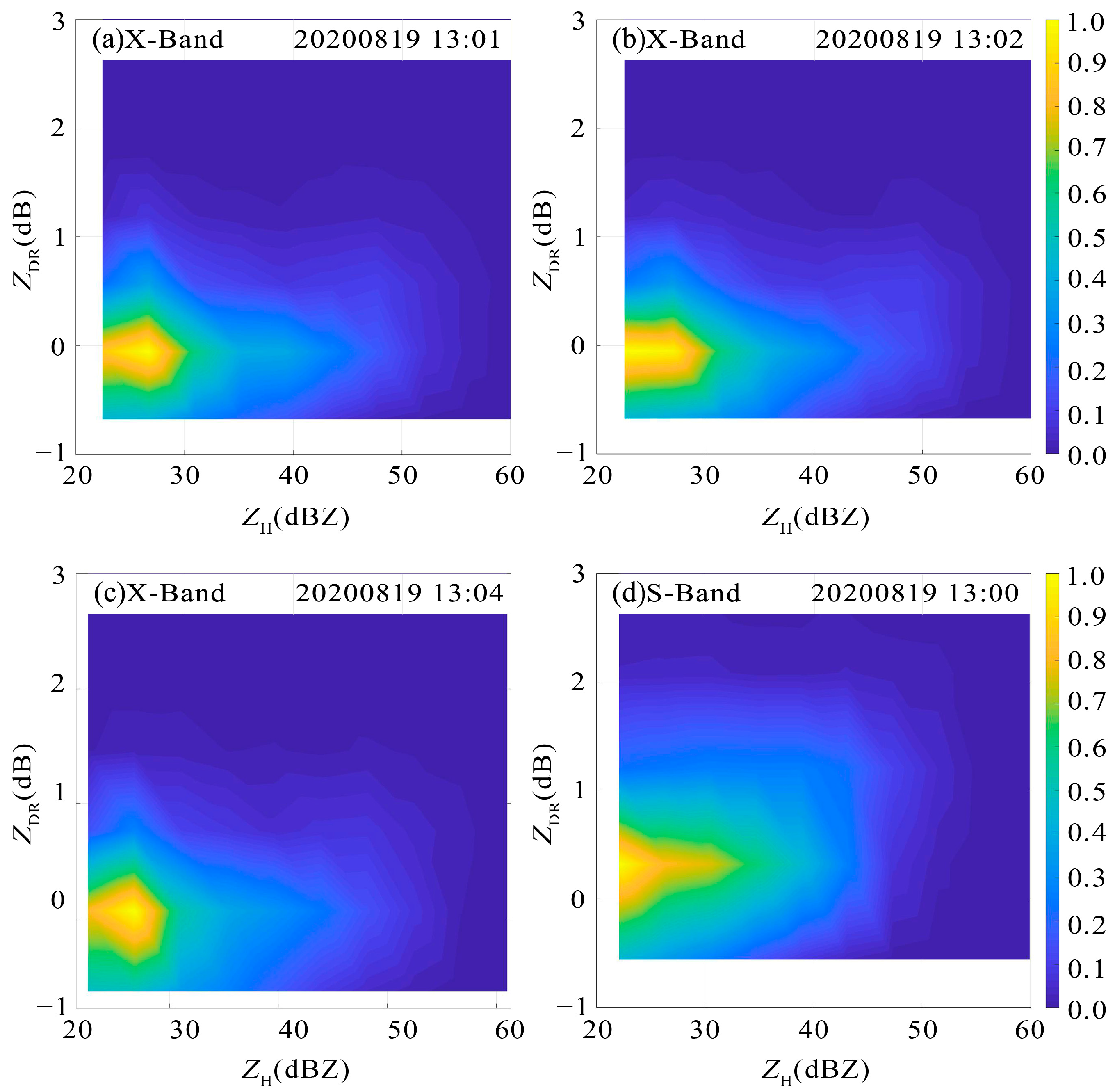
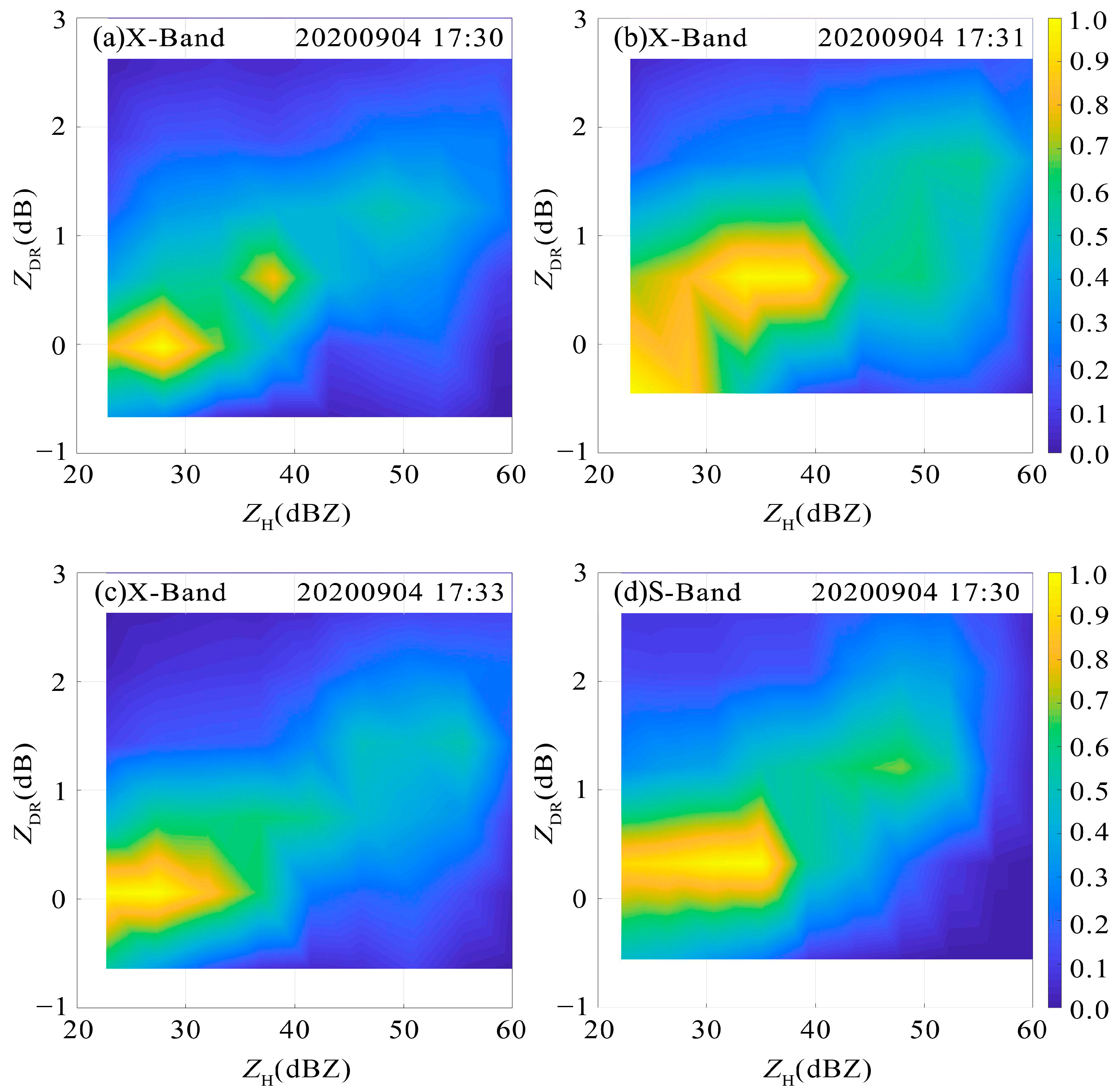
| X-Band | S-Band | |||
|---|---|---|---|---|
| Type | a | b | a | b |
| R(Zh) | 0.046 | 0.638 | 0.0352 | 0.6727 |
| R(KDP) | 21.75 | 0.84 | 58.01 | 0.785 |
| Hourly Accumulated Rainfall (mm) | X-Band | S-Band | ||||
|---|---|---|---|---|---|---|
| NE | RMSE | CC | NE | RMSE | CC | |
| R < 10 | 0.64 | 4.04 | 0.3 | 0.63 | 4.5 | 0.31 |
| 10 < R < 30 | 0.26 | 6.21 | 0.7 | 0.34 | 5.68 | 0.6 |
| R > 30 | 0.13 | 5.68 | 0.95 | 0.20 | 10.28 | 0.92 |
| Rain Type | QPE Type | NE | RMSE (mm) | CC |
|---|---|---|---|---|
| pre-summer | X-band | 0.24 | 6.33 | 0.97 |
| rainfall | S-band | 0.33 | 9.29 | 0.94 |
| typhoon | X-band | 0.24 | 4.49 | 0.9 |
| precipitation | S-band | 0.35 | 5.54 | 0.77 |
| severe convective | X-band | 0.39 | 7.2 | 0.84 |
| precipitation | S-band | 0.44 | 10.59 | 0.74 |
Disclaimer/Publisher’s Note: The statements, opinions and data contained in all publications are solely those of the individual author(s) and contributor(s) and not of MDPI and/or the editor(s). MDPI and/or the editor(s) disclaim responsibility for any injury to people or property resulting from any ideas, methods, instructions or products referred to in the content. |
© 2023 by the authors. Licensee MDPI, Basel, Switzerland. This article is an open access article distributed under the terms and conditions of the Creative Commons Attribution (CC BY) license (https://creativecommons.org/licenses/by/4.0/).
Share and Cite
Zhao, G.; Huang, H.; Yu, Y.; Zhao, K.; Yang, Z.; Chen, G.; Zhang, Y. Study on the Quantitative Precipitation Estimation of X-Band Dual-Polarization Phased Array Radar from Specific Differential Phase. Remote Sens. 2023, 15, 359. https://doi.org/10.3390/rs15020359
Zhao G, Huang H, Yu Y, Zhao K, Yang Z, Chen G, Zhang Y. Study on the Quantitative Precipitation Estimation of X-Band Dual-Polarization Phased Array Radar from Specific Differential Phase. Remote Sensing. 2023; 15(2):359. https://doi.org/10.3390/rs15020359
Chicago/Turabian StyleZhao, Guo, Hao Huang, Ye Yu, Kun Zhao, Zhengwei Yang, Gang Chen, and Yu Zhang. 2023. "Study on the Quantitative Precipitation Estimation of X-Band Dual-Polarization Phased Array Radar from Specific Differential Phase" Remote Sensing 15, no. 2: 359. https://doi.org/10.3390/rs15020359
APA StyleZhao, G., Huang, H., Yu, Y., Zhao, K., Yang, Z., Chen, G., & Zhang, Y. (2023). Study on the Quantitative Precipitation Estimation of X-Band Dual-Polarization Phased Array Radar from Specific Differential Phase. Remote Sensing, 15(2), 359. https://doi.org/10.3390/rs15020359








